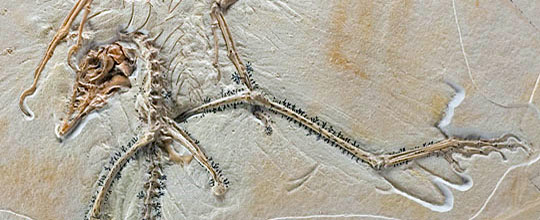Archaeopteryx and the origin of birds
9 February – 15 June 2008
On February 8 a new special exhibition opened in the Phyletisches Museum dedicated to the “first bird”. Archaeopteryx is probably the best-known fossil in existence. The first specimen was found in 1860, shortly after the publication of Charles Darwin’s theory of evolution. Archaeopteryx displays both the characteristics of modern birds and some original reptile-like features, and is thus deemed to be the key piece of evidence attesting to evolution. Although current opinion holds that Archaeopteryx is not a direct ancestor of today’s birds, it still plays a very important role in scientific debates about the origin of birds. It is now believed that birds are descended from two-legged predatory dinosaurs known as theropods, a group which also includes the famous Tyrannosaurus.
The museum has precise casts of all ten known Archaeopteryx fossils, including the best-preserved tenth specimen, which was only found recently. Each fossil is presented together with a short “biography” and details of the place it was found. In addition, a model of the living creature is on display, and the relationships between the specimens and the peculiarities of the tenth example are explained in detail.
A broad cross-section of today’s birds is also presented, from the flamingo to the golden eagle and the swift to the skua. The exhibition will run until the middle of June 2008. It has been created with the support of the Senckenberg Museum in Frankfurt and is directed particularly at school groups, as Archaeopteryx is a celebrated textbook example of evolutionary biology.



